 полная версия
полная версияStories of Useful Inventions

S. E. Forman
Stories of Useful Inventions
PREFACE
In this little book I have given the history of those inventions which are most useful to man in his daily life. I have told the story of the Match, the Stove, the Lamp, the Forge, the Steam-Engine, the Plow, the Reaper, the Mill, the Loom, the House, the Carriage, the Boat, the Clock, the Book, and the Message. From the history of these inventions we learn how man became the master of the world of nature around him, how he brought fire and air and earth and water under his control and compelled them to do his will and his work. When we trace the growth of these inventions we at the same time trace the course of human progress. These stories, therefore, are stories of human progress; they are chapters in the history of civilization.
And they are chapters which have not hitherto been brought together in one book. Monographs on most of the subjects included in this book have appeared, and excellent books about modern inventions have been written, but as far as I know, this is the first time the evolution of these useful inventions has been fully traced in a single volume.
While preparing the stories I have received many courtesies from officers in the Library of Congress and from those of the National Museum.
S. E. F.May, 1911.Washington, D. C.A FOREWORD 1
These stories of useful inventions are chapters in the history of civilization and this little book is a book of history. Now we are told by Herodotus, one of the oldest and greatest of historians, that when the writer of history records an event he should state the time and the place of its happening. In some kinds of history – in the history of the world's wars, for example, or in the history of its politics – this is strictly true. When we are reading of the battle of Bunker Hill we should be told precisely when and where the battle was fought, and in an account of the Declaration of Independence the time and place of the declaration should be given. But in the history of inventions we cannot always be precise as to dates and places. Of course it cannot be told when the first plow or the first loom or the first clock was made. Inventions like these had their origin far back in the earliest ages when there was no such person as a historian. And when we come to the history of inventions in more recent times the historian is still sometimes unable to discover the precise time and place of an invention.
It is in the nature of things that the origin of an invention should be surrounded by uncertainty and doubt. An invention, as we shall see presently, is nearly always a response to a certain want. The world wants something and it promises a rich reward to one who will furnish the desired thing. The inventor, recognizing the want, sets to work to make the thing, but he conducts his experiments in secret, for the reason that he does not want another to steal his ideas and get ahead of him. We can see that this is true in respect to the flying machine. The first experiments with the flying machine were conducted in secret in out of the way places and pains were taken that the public should know as little as possible about the new machine and about the results of the experiments. The history of the flying machine will of course have to be written, but because of the secrecy and mystery which surrounded the beginnings of the invention it will be extremely difficult for the future historian to tell precisely when the first flying machine was invented or to name the inventor. If it is so difficult to get the facts as to the origin of an invention in our own time, how much more difficult it is to clear away the mystery and doubt which surround the beginnings of an invention in an age long past!
In a history of inventions, then, the historian cannot be precise in respect to dates and places. Fortunately this is not a cause for deep regret. It is not a great loss to truth that we cannot know precisely when the first book was printed, nor does it make much difference whether that book was printed in Holland or in Germany. In giving an account of an invention we may be content to treat the matter of time and place broadly, for the story is apt to carry us through a stretch of years that defies computation, a stretch that is immensely longer than the life of any nation. For our purpose these millenniums, these long stretches of time, may be thought of as being divided into three great periods, namely: the primitive, the ancient, and the modern period. Even a division so broad as this is not satisfactory, for in the progress of their inventions all countries have not kept equal step with the march of time. In some things ancient Greece was modern, while in most things modern Alaska is primitive and modern China is ancient. Nevertheless it will be convenient at times in this book to speak of the primitive, the ancient and the modern periods, and it will be useful to regard the primitive period as beginning with the coming of man on earth and extending to the year 5000 B. C.; the ancient period may be thought of as beginning with the year 5000 B. C. and ending with the year 476 A. D., leaving for the modern period the years that have passed since 476 A. D.
In tracing the growth of an invention the periods indicated above can serve as a time-guide only for those parts of the world where the course of civilization has taken its way, for invention and civilization have traveled the same road. The region of the world's most advanced civilization includes the lands bordering on the Mediterranean Sea, Central and Northern Europe, the British Isles, North America, South America and Australia. It is within this region that we shall follow the development of whatever invention is under consideration. When speaking of the first forms of an invention, however, it will sometimes be necessary, when an illustration is desired, to draw upon the experience of people who are outside of the wall of civilization. The reason for going outside is plain. The first and simplest forms of the useful inventions have utterly perished in civilized countries, but they still exist among savage and barbarous peoples and it is among such peoples that the first forms must be studied. Thus in the story of the clock, we must go to a far-off peninsula of Southern Asia (p. 190) for an illustration of the beginning of our modern timepiece. Such a departure from the beaten track of civilization does not spoil the story, for as a rule, the rude forms of inventions found among the lowest races of to-day are precisely the same forms that were in use among the Egyptians and Greeks when they were in their lowest state.
When studying the history of an invention there are two facts or principles which should ever be borne in mind. The first principle is this: Necessity is the mother of invention. This principle was touched upon when it was said that an invention appears as a response to a want. When the world wants an invention it usually gets it and makes the most of it, but it will have nothing to do with an invention it does not want. The steam-engine was invented two thousand years ago (p. 55) but the world then had no work for steam to do, so the invention attracted little attention and came to naught. About two hundred years ago, however, man did want the services of steam and inventors were not long in supplying the engine that was needed. About a hundred years ago the broad prairie lands of the United States began to be tilled but it was soon found that the vast areas could not be plowed and that the immense crops could not be harvested by the old methods. So improvements upon the plow and the reaper began to be made and in time the steam gang-plow and the complete harvester were invented. When the locomotive first came into use a simple handbrake was used to stop the slow-going trains, but as the size and the speed of trains increased the handbrake became more and more unsatisfactory. Sometimes a train would run as much as a half mile beyond a station before it could be stopped and then when "backed" it would again pass beyond the station. The problem of stopping the train promptly became fully as important as starting it. The problem was solved by the invention of the air-brake. And thus it has been with all the inventions which surround us: necessity has been the mother of them all.
The other principle is that a mechanical invention is a growth, or, to state the truth in another way, an invention nearly always is simply an improvement upon a previous invention. The loom, for example, was not invented by a particular person at a particular time; it did not spring into existence in a day with all its parts perfected; it grew, century by century, piece by piece. In the stories which will follow the steps in the growth of an invention are shown in the illustrations. These pictures are not for amusement but for study. As you read, examine them carefully and they will teach you quite as much about the growth of the invention as you can be taught by words.
THE MATCH
Did you ever think how great and how many are the blessings of fire? Try to think of a world without fire. Suppose we should wake up some bitter cold morning and find that all the fires in the world were out, and that there was no way of rekindling them; that the art of kindling a fire had been lost. In such a plight we should all soon be shivering with the cold, for our stoves and furnaces could give us no warmth; we should all soon be hungry, for we could not cook our food; we should all soon be idle, for engines could not draw trains, wheels of factories could not turn, and trade and commerce would come to a standstill; at night we would grope in darkness, for we could use neither lamp nor gas nor electric light. It is easy to see that without fire, whether for light or heat, the life of man would be most wretched.
There never was a time when the world was without fire, but there was a time when men did not know how to kindle fire; and after they learned how to kindle one, it was a long, long time before they learned how to kindle one easily. In these days we can kindle a fire without any trouble, because we can easily get a match; but we must remember that the match is one of the most wonderful things in the world, and that it took men thousands of years to learn how to make one. Let us learn the history of this familiar little object, the match.
Fire was first given to man by nature itself. When a forest is set on fire by cinders from a neighboring volcano, or when a tree is set ablaze by a thunderbolt, we may say that nature strikes a match. In the early history of the world, nature had to kindle all the fires, for man by his own effort was unable to produce a spark. The first method, then, of getting fire for use was to light sticks of wood at a flame kindled by nature – by a volcano, perhaps, or by a stroke of lightning. These firebrands (Fig. 1) were carried to the home and used in kindling the fires there. The fire secured in this way was carefully guarded and was kept burning as long as possible. But the flame, however faithfully watched, would sometimes be extinguished. A sudden gust of wind or a sudden shower would put it out. Then a new firebrand would have to be secured, and this often meant a long journey and a deal of trouble.
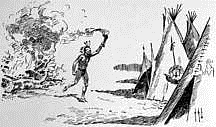
FIG. 1. – GETTING A MATCH FROM NATURE.
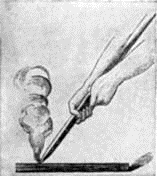
FIG. 2. – PRIMITIVE FIRE-MAKING. THE STICK-AND-GROOVE METHOD.
In the course of time a man somewhere in the world hit upon a plan of kindling a fire without having any fire to begin with; that is to say, he hit upon a plan of producing a fire by artificial means. He knew that by rubbing his hands together very hard and very fast he could make them very warm. By trial he learned that by rubbing two pieces of dry wood together he could make them very warm. Then he asked himself the question: Can a fire be kindled by rubbing two pieces of wood together, if they are rubbed hard enough? He placed upon the ground a piece of perfectly dry wood (Fig. 2) and rubbed this with the end of a stick until a groove was made. In the groove a fine dust of wood – a kind of sawdust – was made by the rubbing. He went on rubbing hard and fast, and, behold, the dust in the groove began to glow! He placed some dry grass upon the embers and blew upon them with his breath, and the grass burst into a flame.2 Here for the first time a man kindled a fire for himself. He had invented the match, the greatest invention, perhaps, in the history of the world.

FIG. 3. – THE FIRE DRILL.
(Simple Form.)
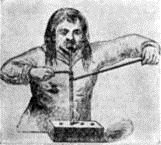
FIG. 4. – FIRE DRILL.
(Improved Form.)
The stick-and-groove method – as we may call it – of getting a flame was much better than guarding fire and carrying it from place to place; yet it was, nevertheless, a very clumsy method. The wood used had to be perfectly dry, and the rubbing required a vast amount of work and patience. Sometimes it would take hours to produce the spark. After a while – and doubtless it was a very long while – it was found that it was better to keep the end of the stick in one spot and twirl it (Fig. 3) than it was to plow to and fro with it. The twirling motion made a hole in which the heat produced by the friction was confined in a small space. At first the drilling was done by twirling the stick between the palms of the hands, but this made the hands too hot for comfort, and the fire-makers learned to do the twirling with a cord or thong3 wrapped around the stick (Fig. 4). You see, the upper end of the stick which serves as a drill turns in a cavity in a mouthpiece which the operator holds between his teeth. If you should undertake to use a fire-drill of this kind, it is likely that your jaws would be painfully jarred.
By both the methods described above, the fire was obtained by rubbing or friction. The friction method seems to have been used by all primitive peoples, and it is still in use among savages in various parts of the world.
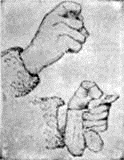
FIG. 5. – STRIKING FIRE.
The second step in fire-making was taken when it was discovered that a spark can be made by striking together a stone and a piece of iron ore. Strike a piece of flint against a piece of iron ore known as pyrites, or fire-stone, and you will make sparks fly. (Fig. 5.) Let these sparks fall into small pieces of dried moss or powdered charcoal, and the tinder, as the moss or the charcoal is called, will catch fire. It will glow, but it will not blaze. Now hold a dry splinter in the glowing tinder, and fan or blow with the breath and the splinter will burst into a flame. If you will tip your splinter with sulphur before you place it in the burning tinder, you will get a flame at once. This was the strike-a-light, or percussion, method of making a fire. It followed the friction method, and was a great improvement upon it because it took less work and a shorter time to get a blaze. The regular outfit for fire-making with the strike-a-light consisted of a tinder-box, a piece of steel, a piece of flint, and some splinters tipped with sulphur (Fig. 6). The flint and steel were struck together, and the sparks thus made fell into the tinder and made it glow. A splinter was applied as quickly as possible to the tinder, and when a flame was produced the candle which rested in the socket on the tinder-box was lighted. As soon as the splinter was lighted the cover was replaced on the tinder-box, so as to smother the glowing tinder and save it for another time.
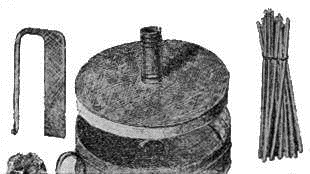
FIG. 6. – TINDER BOX, FLINT, STEEL, AND SULPHUR-TIPPED SPLINTERS.
The strike-a-light method was discovered many thousands of years ago, and it has been used by nearly all the civilized nations of the world.4 And it has not been so very long since this method was laid aside. There are many people now living who remember when the flint and steel and tinder-box were in use in almost every household.
About three hundred years ago a third method of producing fire was discovered. If you should drop a small quantity of sulphuric acid into a mixture of chlorate of potash and sugar, you would produce a bright flame. Here was a hint for a new way of making a fire; and a thoughtful man in Vienna, in the seventeenth century, profited by the hint. He took one of the sulphur-tipped splinters which he was accustomed to use with his tinder-box, and dipped it into sulphuric acid, and then applied it to a mixture of chlorate of potash and sugar. The splinter caught fire and burned with a blaze. Here was neither friction nor percussion. The chemical substances were simply brought together, and they caught fire of themselves; that is to say, they caught fire by chemical action.
The discovery made by the Vienna man led to a new kind of match – the chemical match. A practical outfit for fire-making now consisted of a bottle of sulphuric acid (vitriol) and a bundle of splints tipped with sulphur, chlorate of potash, and sugar. Matches of this kind were very expensive, costing as much as five dollars a hundred; besides, they were very unsatisfactory. Often when the match was dipped into the acid it would not catch fire, but would smolder and sputter and throw the acid about and spoil both the clothes and the temper. These dip-splint matches were used in the eighteenth century by those who liked them and could afford to buy them. They did not, however, drive out the old strike-a-light and tinder-box.
In the nineteenth century – the century in which so many wonderful things were done – the fourth step in the development of the match was taken. In 1827, John Walker, a druggist in a small English town, tipped a splint with sulphur, chlorate of potash, and sulphid of antimony, and rubbed it on sandpaper, and it burst into flame. The druggist had discovered the first friction-chemical match, the kind we use to-day. It is called friction-chemical because it is made by mixing certain chemicals together and rubbing them. Although Walker's match did not require the bottle of acid, nevertheless it was not a good one. It could be lighted only by hard rubbing, and it sputtered and threw fire in all directions. In a few years, however, phosphorus was substituted on the tip for antimony, and the change worked wonders. The match could now be lighted with very little rubbing, and it was no longer necessary to have sandpaper upon which to rub it. It would ignite when rubbed on any dry surface, and there was no longer any sputtering. This was the phosphorus match, the match with which we are so familiar.

FIG. 7. – A "BLOCK" OF MATCHES.
After the invention of the easily-lighted phosphorus match there was no longer use for the dip-splint or the strike-a-light. The old methods of getting a blaze were gradually laid aside and forgotten. The first phosphorus matches were sold at twenty-five cents a block – a block (Fig. 7) containing a hundred and forty-four matches. They were used by few. Now a hundred matches can be bought for a cent. It is said that in the United States we use about 150,000,000,000 matches a year. This, on an average, is about five matches a day for each person.
There is one thing against the phosphorus match: it ignites too easily. If one is left on the floor, it may be ignited by stepping upon it, or by something falling upon it. We may step on a phosphorus match unawares, light it, leave it burning, and thus set the house on fire. Mice often have caused fires by gnawing the phosphorus matches and igniting them. In one city thirty destructive fires were caused in one year by mice lighting matches.
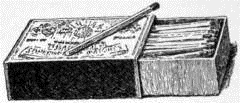
FIG. 8. – A BOX OF MODERN SAFETY MATCHES.
To avoid accident by matches, the safety match (Fig. 8) has recently been invented. The safety match does not contain phosphorus. The phosphorus is mixed with fine sand and glued to the side of the box in which the matches are sold. The safety match, therefore, cannot be lighted unless it is rubbed on the phosphorus on the outside of the box. It is so much better than the old kind of phosphorus match that it is driving the latter out of the market. Indeed, in some places it is forbidden by law to sell any kind of match but the safety match.
The invention of the safety match is the last step in the long history of fire-making. The first match was lighted by rubbing, and the match of our own time is lighted by rubbing; yet what a difference there is between the two! With the plowing-stick or fire-drill it took strength and time and skill to get a blaze; with the safety match an awkward little child can kindle a fire in a second.
And how long it has taken to make the match as good as it is! The steam-engine, the telegraph, the telephone, and the electric light were all in use before the simple little safety match.
THE STOVE
From the story of the match you have learned how man through long ages of experience gradually mastered the art of making a fire easily and quickly. In this chapter, and in several which are to follow, we shall have the history of those inventions which have enabled man to make the best use of fire. Since the first and greatest use of fire is to cook food and keep the body warm, our account of the inventions connected with the use of fire may best begin with the story of the stove.
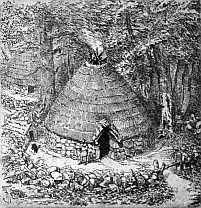
FIG. 1. – THE PRIMITIVE STOVE.
The most important uses of fire were taught by fire itself. As the primitive man stood near the flames of the burning tree and felt their pleasant glow, he learned that fire may add to bodily comfort; and when the flames swept through a forest and overtook a deer and baked it, he learned that fire might be used to improve the quality of his food. The hint was not lost. He took a burning torch to his cave or hut and kindled a fire on his floor of earth. His dwelling filled with smoke, but he could endure the discomfort for the sake of the fire's warmth, and for the sake of the toothsomeness of the cooked meats. After a time a hole was made in the roof of the hut, and through this hole the smoke passed out. Here was the first stove. The primitive stove was the entire house; the floor was the fireplace and the hole in the roof was the chimney (Fig. 1). The word "stove" originally meant "a heated room." So that if we should say that at first people lived in their stoves, we should say that which is literally true.
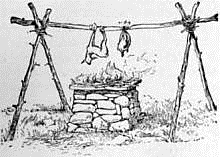
FIG. 2. – PRIMITIVE COOKING.
Early inventions in cooking consisted in simple devices for applying flame directly to the thing which was to be cooked. The first roasting was doubtless done by fastening the flesh to a pole placed in a horizontal position above the fire and supported as is shown in Figure 2.5 The horizontal bar called a spit was originally of wood, but after man had learned to work in metals an iron bar was used. When one side of the flesh was roasted the spit was turned and the other side was exposed to the flames. The spit of the primitive age was the parent of the modern grill and broiler.
Food was first boiled in a hole in the ground. A hole was filled with water into which heated stones were thrown. The stones, by giving off their heat, caused the water to boil in a very short time. After the art of making vessels of clay was learned, food was boiled in earthen pots suspended above the fire.

